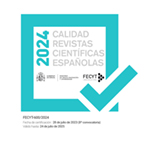Translating genres, creating transgenres: Textual 'betweens' as situation-based systemic innovations
Resumen
Este artículo trabaja la noción de transgénero (Monzó-Nebot 2001a, 2002a, b), sus usos y posibilidades en el estudio de la traducción como mediadora en la cooperación intercultural. Los transgéneros son patrones discursivos que se desarrollan en situaciones interculturales recurrentes y son reconocidos y utilizados por una comunidad. Sobre la base de la reiteración de los propósitos comunicativos y las funciones de los individuos en las situaciones traducidas, las interacciones se convencionalizan para racionalizar la cooperación entre los grupos culturales y sociales, lo que genera un conjunto distintivo de supuestos asumidos, signos y mecanismos de creación de significado que son particulares de una situación traducida. En el artículo se argumentará en primer lugar que este concepto va más allá de las propuestas existentes de los enfoques culturales, sociales y lingüísticos, especialmente el tercer espacio, los modelos de normas y leyes de la traducción, y los universales y el lenguaje de la traducción (translationese), al centrarse en el carácter arraigado en una situación de las pautas textuales, de interacción y culturales; por ello, proporciona un medio para modelar y medir el desarrollo de la traducción como práctica discursiva, influida por cuestiones históricas, culturales, sociales, cognitivas, ideológicas y lingüísticas. A continuación, se identifican y exponen las aplicaciones existentes del concepto y nuevas posibilidades. Los resultados de los estudios existentes muestran que las traducciones construyen un tercer espacio de prácticas discursivas interculturales que muestran las tensiones con los sistemas de origen y de destino. En ese tercer espacio, resultante de sus propias prácticas culturales vinculadas a la función específica de los traductores en un sistema multicultural más amplio, el traductor jurídico se siente en su propio medio.
Descargas
Descarga artículo
Licencia
La revista Estudios de Traducción, para fomentar el intercambio global del conocimiento, facilita el acceso sin restricciones a sus contenidos desde el momento de su publicación en la presente edición electrónica, y por eso es una revista de acceso abierto. Los originales publicados en esta revista son propiedad de la Universidad Complutense de Madrid y es obligatorio citar su procedencia en cualquier reproducción total o parcial. Todos los contenidos se distribuyen bajo una licencia de uso y distribución Creative Commons Reconocimiento 4.0 (CC BY 4.0). Esta circunstancia ha de hacerse constar expresamente de esta forma cuando sea necesario. Puede consultar la versión informativa y el texto legal de la licencia.









